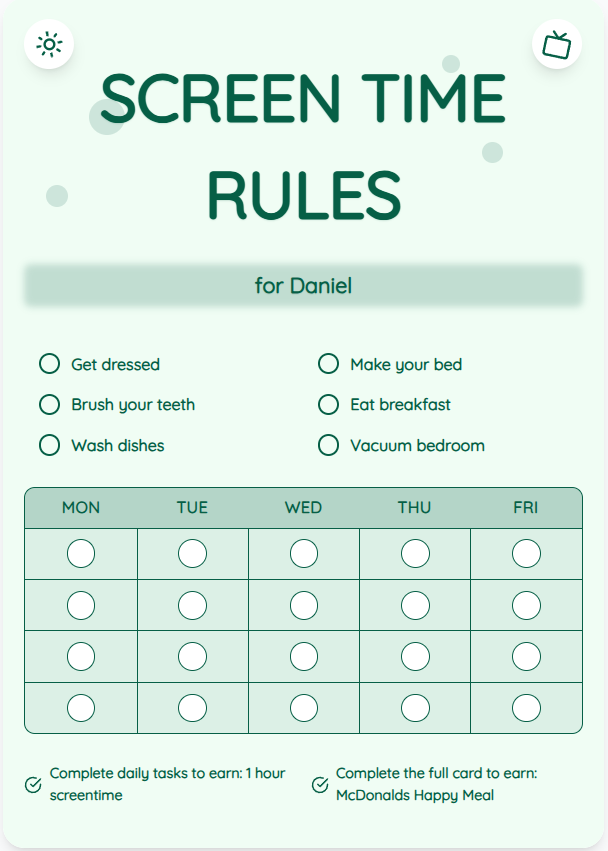Limiting Screen Time for Adults: A Guide for Parents
In today's digital age, managing screen time for adults is just as important as it is for children. Finding a balance between screen use and other activities can greatly benefit family relationships and overall well-being. This guide offers actionable advice and practical tips to help adults reduce screen time and enhance quality time with loved ones.
See What Your Screen Time Chart Will Look Like
Here's an example of a beautiful, customizable screen time rules chart you can create for your family

Understanding the Impact of Excessive Screen Time
Excessive screen time can lead to various health issues, including eye strain, poor posture, sleep disturbances, and decreased physical activity. Moreover, it can also affect communication within the family and hinder bonding opportunities. By recognizing these impacts, adults can take proactive steps to limit their screen time.
Setting Realistic Screen Time Limits
Establishing clear boundaries and setting realistic screen time limits are essential. Create a schedule that includes designated screen-free times, such as during meals or before bedtime. Communicate these limits with family members to ensure everyone is on the same page.
Put These Tips Into Action
Create a custom chart to implement these strategies with your child
Exploring Alternative Activities
Encourage adults to explore alternative activities that do not involve screens. This could include outdoor walks, board games, reading books, or pursuing hobbies. By diversifying leisure activities, adults can reduce their dependence on screens and discover new sources of enjoyment.
Utilizing Screen Time Charts as a Solution
Screen time charts can serve as effective tools for managing screen time for adults. These charts visually represent allotted screen time slots and can help individuals track their usage throughout the day. Consider using ScreenTimeRules.com's screen time chart generator to create personalized schedules tailored to your family's needs.
Practical Tips for Success
- Create a designated 'no-screen zone' in certain areas of your home.
- Use technology features like screen time tracking apps to monitor usage.
- Engage in physical activities as a family to reduce screen time temptation.
- Establish a screen-free bedtime routine to promote better sleep.
Frequently Asked Questions
How can adults model healthy screen time habits for their children?
Adults can set a positive example by limiting their own screen time, engaging in offline activities, and prioritizing face-to-face interactions with their children.
Is it necessary to completely eliminate screen time for adults?
While complete elimination may not be feasible or necessary, setting reasonable limits and balancing screen time with other activities is key to maintaining a healthy lifestyle.
How can adults resist the urge to constantly check their devices?
Practicing mindfulness techniques, such as setting specific 'device-free' hours or engaging in hobbies that require full attention, can help adults curb the habit of constantly checking their devices.
By actively managing screen time and embracing alternative activities, adults can create a healthier digital balance that benefits both themselves and their families. Consider implementing the tips and strategies shared in this guide to cultivate a more mindful approach towards screen use. For personalized screen time management solutions, explore ScreenTimeRules.com's screen time chart generator today!
Ready to Transform Your Family's Screen Time?
Join thousands of parents who have successfully managed screen time with our customizable charts.
